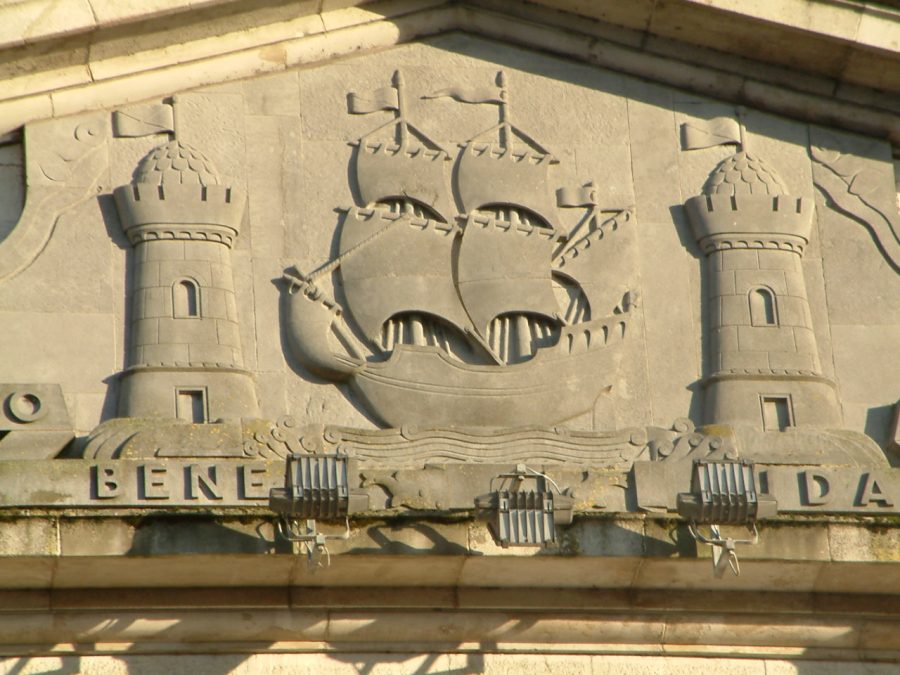
“The Watcher”
Carvings and Meanings:
Congratulations Lord Mayor on a really great year as a leader in Cork.
I’d like to v briefly tell a story.
In my daily evening walks around Cork during the heart of the lockdown in April and May, empty streets spanning for entire vistas make for some interesting photography opportunities. And features, which you wouldn’t normally see because of the cars and busyness usually at the forefront. One of the features I began to photograph on my solo walks were the depictions of the city’s Coat of Arms on various buildings and in public spaces.
There has never been any history project compiling these pieces – some are stone carvings, some are mosaics, some are plaster casts, and of course some are pure gold in terms of the Lord Mayor’s chain.
All the pieces on buildings are from different eras, where the civicness of Cork was drawn upon when needed and usually the building on which they appear was important to Cork’s future and the idea of pulling people together to build a resilient future.
The theme of togetherness, which was very prevalent in your year of office, was one you championed very well– the thread of togetherness was at the heart of the boundary extension last June and at the heart of the Community Response team and even this week at the launch of the Council’s regeneration social housing project, which you launched.
Some of the Coat of Arms depictions are more thought provoking than others with liberty taken to etch in some features within and outside of the Coat of Arms spaces especially adjacent the Latin inscription of Statio Bene Fida Carinis or the safe harbour for ships. Certainly, the journey to having an official registered coat of arms in 1949 – a document, which hangs in the Lord Mayor’s office – has been several centuries in the making.
Versions of the Past:
My solo walks led me to doing research in the oldest of Cork’s newspapers, which are now online. An archival record of a seal cast from 1498 records the original Coat of Arms, which was just one castle with two towers coming out from either side; a person stands in one tower with a bow, and in the other a person blows a trumpet. A bridge connects the two towers in the background, and beyond which a ship is seen.
During this year I didn’t see you blowing your own trumpet but perhaps you symbolised the bowman, serving the office of Lord Mayor with accuracy, credibility and professionalism.
Nearly 200 years ago, in 1825 a digging up beneath the floors on North Main Street around Castle Street and the site of the reputed medieval custom house – a stone carving of a coat of arms was discovered, which local historians at the time said it came from the early 1600s.
The stone has been lost to time but a pen and ink sketch by early nineteenth century Cork artist Daniel Maclise of it still can be viewed in our public museum. The sketch shows the Coat of Arms having being upgraded again since the 1400s version. The arms was now a ship between two towers or castles with a sailor in Elizabethan period dress and a bird, both on the rigging of the ship.
There is no record to who was the Elizabethan Sailor and clearly the sailor and the bird did not make it into the modern day depictions.
But certainly there is a sense in the old coat of arms depictions of denoting those who looked upon Cork from a physical height, and to reflect on their very responsible posts in protecting and watching over the infrastructure of the physical walled town of Cork, the shipping docked within its walls or over its citizens.
Very little information has been gathered on who could be called the watchers, who they were, their experiences, what they saw of everyday life from their physical height, and their perspective on citizenry.
A Watcher of a City:
I would deem you one of the core positive Cork watchers in the present day.
It is very clear that you are someone who is aware through your professional work and other hats, the importance of the physical space of Cork for people’s health plus also the importance of the human spirit and maintaining the resilience of such. One of the most apt terms you used this week in one your speeches this week was– Ar Scáth a Chéile a Mhairimid or ‘We live in each other’s shadows’.
You certainly championed the importance of people’s stories of resilience for the greater good of the community and the city – whether that be the Mary Elmes story, those who sat on the council in 1920 during such turbulent times, the stories of Tomás MacCurtain and Terence MacSwiney, those who you gave Lord Mayor’s community awards to, or those who you met on your community visits in recent visits.
The beliefs you champion about people and their voices, and the importance of listening and being listened to need to continue to be the bedrock of Cork’s rebuilding into the future.
I want to sincerely thank you for your work and know that historically the City will not forget your service especially over the past 12 months for not just embodying the symbolism of the coat of arms but also pushing for a safe harbour or place for all citizens.
I’d also like to give a nod of congrats to the Deputy Lord Mayor, Cllr Sean Martin, who I listened to with impressiveness at many public events, when he let his historical knowledge loose.
Once again sincere thanks to you Lord Mayor, your Deputy and to the Lady Mayoress. Go raibh maith agat.